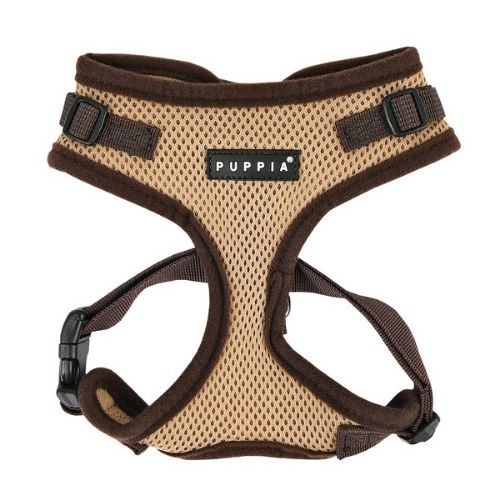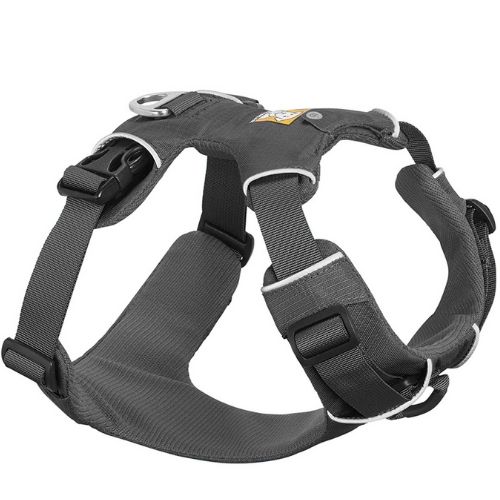You love your fur baby, so you don’t want to risk potential injury with a collar. But you also need them to behave on walks and in public. We feel the same way about our four-legged family members, and we understand how confusing the harness vs. collar dilemma can be.
We dove deep into the world of harnesses and collars to help you understand the nuances, discover top product picks, and protect your furry pal.
What to Consider When Choosing a Pet Harness:
Type of Pet Harnesses
A lot of dog owners don’t even realize that not all pet harnesses are created equal. Understanding the two main types of harnesses will help you choose the right one for you and your furry friend.
1. Body Harnesses
The body harness was first developed for working dogs who pulled heavy loads. It’s designed to evenly distribute pressure from a leash throughout a dog’s body, making it more comfortable for the dog to pull.1
Best Uses for Body Harnesses
Small dogs, cats, and puppies whose fragile necks and spines could easily be hurt by a sudden sharp pull on a leash are prime candidates for body harnesses. These harnesses are also great for older arthritic dogs who need help standing up—a body harness won’t force too much pressure on any one spot.
A body harness with a chest plate is also our first pick for use as a car restraint, as it can evenly distribute the force of impact from a crash. Additionally, body harnesses can help level the playing field for owners of large, unwieldy dogs. In uncertain situations, body harnesses can shift your point of contact with the dog to its center mass, making it easier for you to direct them.
When to Avoid Body Harnesses
Body harnesses may be uncomfortable for dogs with certain skin conditions that make their coats more sensitive.2 Additionally, if you have a dog that likes to drag you down the street on walks, a body harness may make the problem worse. Yes, it gives you more control, but it also makes it easier for them to pull you along. This is where a front-clip harness comes in to play.
2. Front-Clip Harnesses
A front-clip harness for dogs is designed much like a body harness, but it may fit slightly differently, because it has a leash clip on the chest plate of the dog harness as well as a leash attachment at the back. The horizontal straps on front-clip harnesses often partially restrict movement of the shoulders.
Best Uses for Front-Clip Harnesses
Front-clip harnesses are a good training tool if your large dog’s excitement causes them to leash-walk you more than the other way around. Huge, hyper yellow labs, we’re looking at you. A front-clip harness has a chest-centered leash anchor point to direct your dog. This means that every time your dog pulls, their forward momentum turns into rotational energy. In other words, it makes them turn to the side and it slows them down. They quickly learn that pulling results in turning a direction they didn’t want to go.
When to Avoid Front-Clip Harnesses
A front-clip harness is intended for use as a training tool, not a long-term solution. If your dog has learned not to pull and complies with a body harness, a front harness might actually be harmful to them.
Because most front-clip harnesses fit around your dog’s shoulders rather than their neck, using one for an extended period of time can actually interfere with and permanently alter your dog’s natural walking gait.3
Keep in mind that most dual-function harnesses (like the Ruffwear Front Range Harness) are designed to allow freer shoulder movement. This may slightly reduce their training effectiveness, but it makes them more appropriate for long-term use.
Our Top Picks for Pet Harnesses
Best Body Harnesses
1. Puppia RiteFit Harness: For Smaller Pets
We love the comfort and convenience of the Puppia RiteFit Harness for cats, puppies, or smaller pups like dachshunds. It’s made of soft, breathable mesh, with rounded edge seams for added comfort. At under $15, it’s also very affordable, and it comes in smaller sizes than most other harnesses on the market.
Details
- Material: polyester mesh
- Chest girth: 13–31.5 inches
2. Unho Dog Body Harness: For Larger Dogs
The Unho Dog Body Harness has a thick, padded chest strap in place of a chest plate, so there’s no chafing between your dog’s front legs when walking. This allows big dogs like labs or German shepherds to move comfortably and freely. The dog harness also has a sturdy handle on the back so you can maneuver your canine companion when needed.
Details
- Material: nylon
- Chest girth: 19.7–43.3 inches
Best Front-Clip Harnesses
1. PetSafe Easy Walk Dog Harness: Best for Training
We like the PetSafe Easy Walk Dog Harness for its martingale design at the chest that adds just a tiny bit more pressure when your dog pulls on the leash, reminding your dog to ease up. The 1-year anti-chew warranty is another plus of the PetSafe Easy Walk Harness–the company will replace the dog harness for a minimal fee if your dog chews it up within the first year.
Details
- Material: nylon
- Chest girth: 12–50 in.
2. Ruffwear Front Range Harness: Best for Versatility
The Ruffwear Front Range Harness has a padded chest plate, with dual leash attachment rings so you can attach the leash to the back of the harness once your dog has learned not to pull. The harness has four points of adjustment to customize the fit. Plus, it has a pocket for your dog’s identification tags so you never have to be without them.
Details
- Material: nylon and foam
- Chest girth: 17–42 in.
A Word about Collars
In most cases, a dog harness is the safest choice for walking your pet on a leash, controlling behavior in public, and riding in the car. But a collar can also be appropriate under certain circumstances.
Collars to Avoid
Most experts strongly discourage the use of choke collars, prong collars, and shock collars.4 A plain nylon or leather collar is the safest, most humane choice for your pet. Remember that the bigger your pup is, the wider their dog collar should be.
When to Put On a Collar
For safety reasons, it’s important for your pet to always wear ID tags, even at home. But collars are usually a more comfortable option than harnesses when your pup is just hanging out around the house. Collars are also less likely to get caught on kennels and other objects, making them a safer choice when a dog must be left alone.
5 Tips for Introducing Your Pet to a New Harness
It’s not uncommon for pets to be wary of new gear. Here are a few tips to teach your dog to get along with a new harness.
- Test out the harness before its public debut. Help your pup try on the new harness before heading outdoors to ensure a proper, comfortable fit.
- Associate the dog harness with treats or play. During training time, put treats or toys on or near the harness to help your puppy make positive associations with the new harness (just don’t lead your dog to believe it’s a new chew toy).
- Feed treats through the harness. This one is sneaky. Hold up the dog harness with a treat on the other side of the neck hole so your dog has lean through the neck hole to eat the treat. You can also place a toy on the other side of the neck hole.
- Reward touch points. If your pet is sensitive to touch, gently touch the areas of their body where the harness will touch, and reward them with treats or play.
- Practice touching with the harness. Once your pet is comfortable with being touched by hand, use the harness to touch different places on the dog’s body, and reward them with play or treats after each touch.
- Put the harness on for meals and playtime. Once your dog is comfortable with the harness, fasten it on before dinner and playtime. You can take it off afterward. This routine teaches them that wearing the harness leads to good things, mentally preparing them for its use during walks and car rides. Continue rewarding them with praise, treats, or play every time they don the harness.
FAQs
What kind of lead is best for leash walking my dog?
When training a puppy to heel, walk them with a short leather or nylon leash to keep them by your side and under control. Once your dog is well trained and heels on a loose leash, you can use retractable leashes if you want.
Should I consider my dog’s breed when choosing between a harness vs. collar?
Yes. According to Jennifer Coates, DVM, dog breeds with short noses (think pugs, French bulldogs, and Boston terriers) have delicate airways and are prone to respiratory problems. Since using a collar and leash could cause a collapsed trachea for these dog breeds, it’s best to avoid collars—harnesses are a safer choice.4
How do head collars work?
A head collar, also sometimes called a muzzle, halter, halti, or gentle leader, fits around your dog’s nose and neck and attaches to a leash. It gives you control over your dog’s head, thus granting more control over your dog. Halters work well for strong dogs like German shepherds. We recommend that pet owners use head collars only under the supervision of a dog trainer.
What other gear can I use to keep my dog safer?
If you’re looking for other safety gear for dogs, be sure to look into car safety products. It’s also a good idea to consider GPS trackers and collars for dogs, just in case your dog goes AWOL.
Related Resources
Sources
- Simpawtico Dog Training, “Choosing a Dog Harness–Best Ones and How to Use”
- Pet MD, “Surprising Dog Harness Dangers to Avoid”
- Pet MD, “Surprising Dog Harness Dangers to Avoid”
- American Kennel Club, “10 Unexpected Ways You Could Be Hurting Your Pet”, PETA.org, “What are the Dangers of Using Choke and Prong Collars?”, “Prong and Shock Collars and Electric (‘Invisible’) Fences”, American Veterinary Society of Animal Behavior, “AVSAB Position Statement: The Use of Punishment for Behavior Modification in Animals”
- Pet MD, “Why Flat-Faced Breeds Need Dog Harnesses Instead of Collars”
Disclaimer
Amazon.com list price as of 0/31/19 at 4 p.m. MST. Product prices and availability are accurate as of the date/time indicated and are subject to change. Any price and availability information displayed on Amazon at the time of purchase will apply to the purchase of this product. Safewise.com utilizes paid Amazon links.
Certain content that appears on this site comes from Amazon. This content is provided “as is” and is subject to change or removal at any time.
The post Why Pet Harnesses Are (Usually) Better Than Collars appeared first on SafeWise.
from Blog – SafeWise https://ift.tt/36RRBGg
via IFTTT




No comments:
Post a Comment